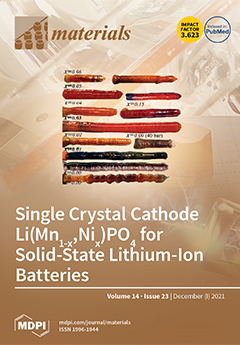Gd and Yb elements have high chemical stability, which can stabilize the solid solution in ZrO
2. Gd
2O
3 and Yb
2O
3 have high melting points, and good oxidation resistance in extreme environments, stable chemical properties. Therefore, Gd
[...] Read more.
Gd and Yb elements have high chemical stability, which can stabilize the solid solution in ZrO
2. Gd
2O
3 and Yb
2O
3 have high melting points, and good oxidation resistance in extreme environments, stable chemical properties. Therefore, Gd
2O
3 and Yb
2O
3 were added to ZrO
2 to stabilize oxides, improve the high temperature stability, and effectively decrease the thermal conductivity at high temperature. In this work, 5 wt% Yb
2O
3 and 5 wt%, 10 wt%, 15 wt% Gd
2O
3 were doped into 8 wt% Y
2O
3 stabilized ZrO
2 (8YSZ) powders as thermal barrier coating materials, and sintered at 1650 °C for 6 h, 12 h, 24 h. The effects of Gd
2O
3 addition on the microstructure, density, thermal conductivity, hardness, and fracture toughness of Gd
2O
3-Yb
2O
3-Y
2O
3-ZrO
2 (GYYZO) bulk composite ceramics were investigated. It was found that the densification of the 8YSZ bulk and GYYZO bulk with 15 wt% Gd
2O
3 reached 96.89% and 96.22% sintered at 1650 °C for 24 h. With the increase of Gd
2O
3 addition, the hardness, elastic modulus and fracture toughness of the GYYZO bulk increased and the thermal conductivity and thermal expansion coefficient of the GYYZO bulk decreased. GYYZO bulk with 15 wt% Gd
2O
3 sintered at 1650 °C for 24h had the highest hardness, elastic modulus and fracture toughness of 15.61 GPa, 306.88 GPa, 7.822 MPa·m
0.5, and the lowest thermal conductivity and thermal expansion coefficient of 1.04 W/(m·k) and 7.89 × 10
−6/°C at 1100 °C, respectively. The addition of Gd
2O
3 into YSZ could not only effectively reduce the thermal conductivity but also improve the mechanical properties, which would improve the thermal barrier coatings’ performances further.
Full article






